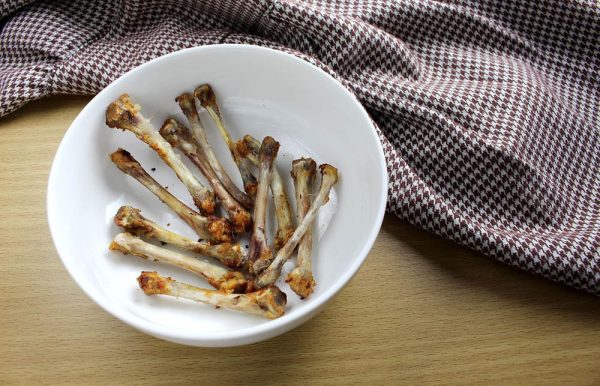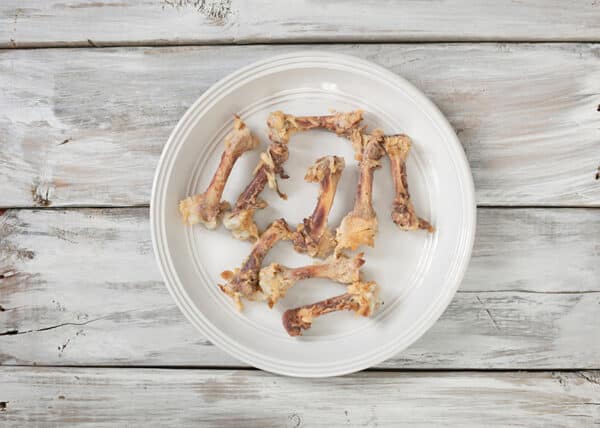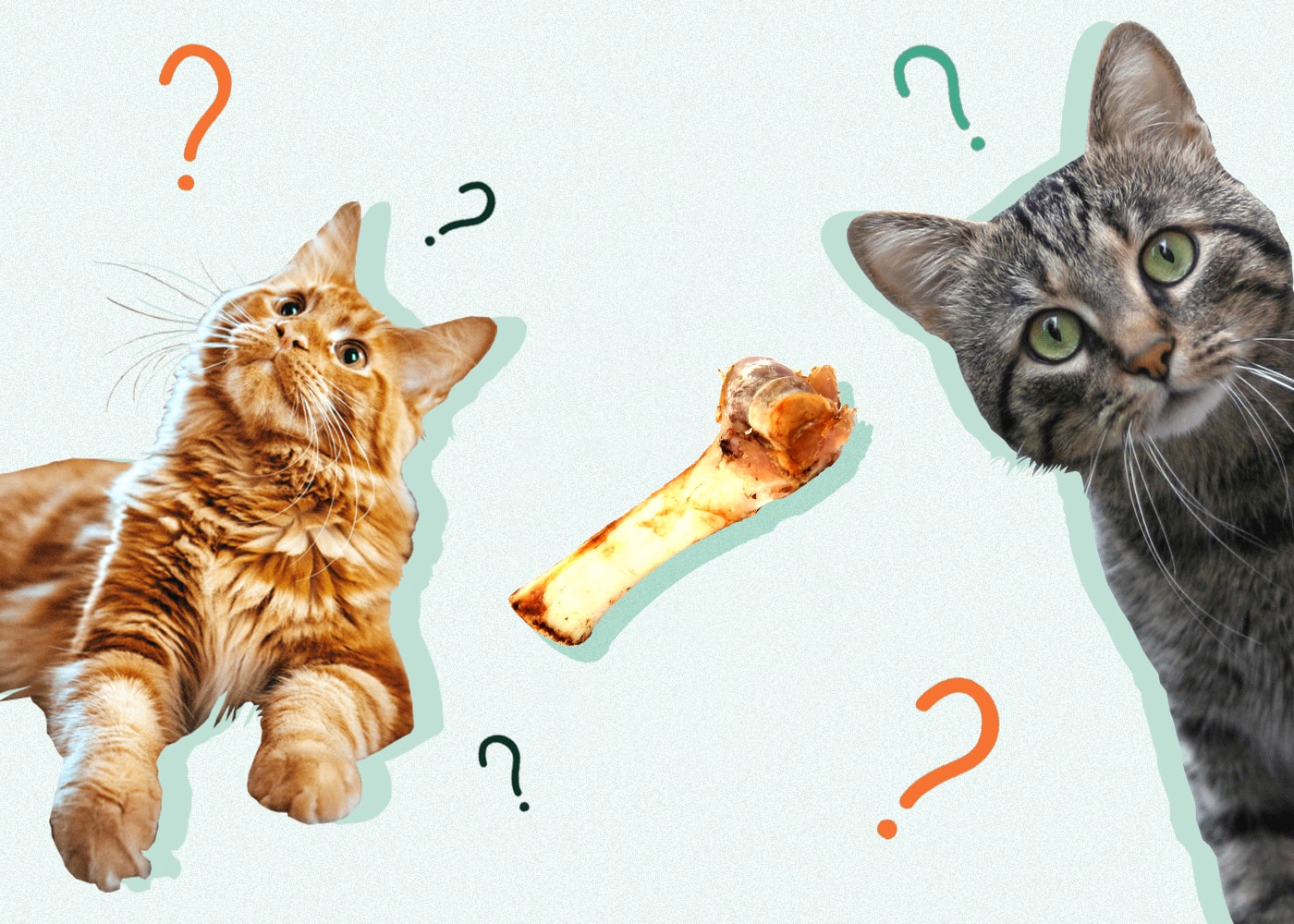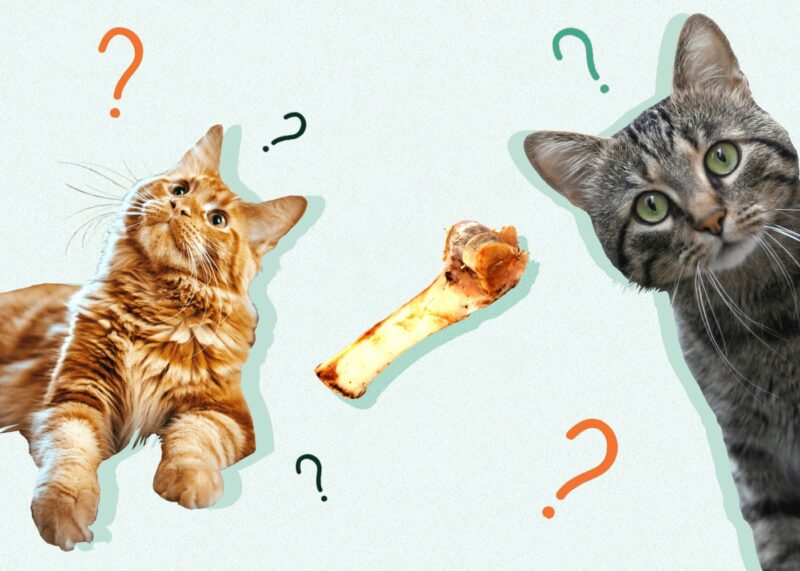Cats just love eating chicken! It can be a healthy part of any cat’s diet. But what about chicken bones? After all, cats out in the wild (or your little hunters at home) catch and eat birds, bones and all. The bones can be an excellent source of minerals, but there’s one significant difference between bones found in the wild and those from our leftovers—they’re raw. Fortunately, cats can eat raw chicken bones.
Raw Chicken Bones vs. Cooked Chicken Bones
Cats come from an ancient line of hunters and are obligate carnivores. Meat and meat by-products are absolute necessities for your little tiger. However, cats can’t eat cooked chicken bones. While they may find them to be tasty treats, there are serious health hazards associated with eating them.

Cooked Chicken Bones Are Brittle
After chicken bones are cooked, they become soft and brittle, and this makes them dangerous for your cats to eat. Instead of the bones being naturally worn down, they snap into small shards. These shards can quickly become lodged in your cat’s throat and cause them to choke. They can also cut into your cat’s mouth and esophageal lining.
Cooked Bones Can Be Covered in Toxic Ingredients
What’s delicious for us isn’t always great for your kitty. Most of the time, when we cook chicken, we season it to enhance its flavor. But some of the seasonings can be very toxic for cats. Garlic powder and onion powder are prime offenders, and they also happen to be some of the most common flavoring agents for chicken prepared for human consumption.
While sharing human food with your cat is not always safe, we have a solution that will keep you both smiling.
We've currently got a 40% discount to share on the HUMAN-GRADE premium cat food that ranked number #1 in our reviews! CLICK HERE & use code Catster24 to SAVE 40% on Smalls cat food!

What to Do If Your Cat Eats a Cooked Chicken Bone
Cats are sneaky, and those that particularly crave chicken might be waiting for their chance to snatch a piece from you. So, what should you do if this happens? First, try to remove bone from the cat’s mouth gently. Hopefully, they haven’t attempted to swallow it whole, or it hasn’t splintered yet. But you must be vigilant if your pet has gobbled down a few shards and pieces. Even once the choking danger has passed, other problems can arise.
Second, call your vet. Let your veterinarian know the situation just in case complications do come up. The next few days after consuming the bone are critical. You need to keep a close eye on your cat to ensure that the bone shards aren’t causing harm as they work through your cat’s GI tract.
Here are signs that you should watch for:
- Lethargy
- Bloating
- Diarrhea
- Bloody stool
- Vomiting
- Disinterest in food
- Gas
- Bone shards in stool
If you notice any of these signs, contact your veterinarian ASAP.
Benefits of Raw Chicken Bones
While cooked chicken bones can be a real and present danger for your cat, raw bones can be excellent treats. They are full of calcium, which is an important part of a cat’s diet. Calcium deficiency can lead to arthritis, coat and skin problems, broken bones, weakness, heart arrhythmias, and worse. Feeding your cat raw bones on occasion can help with their calcium intake.
When feeding raw bones to your cat, be sure to choose ones of an appropriate size for them to gnaw and chew on. Chicken wing bones are the perfect size for a cat. Not only will they fit comfortably in their mouth, but the chewing action will help strengthen and clean their teeth. However, just be sure to keep a watchful eye on your cat while feeding them raw bones.
Another tactic is to feed ground bone to your kitty. You can get it at just about any butcher or meat department. Ask for meat sawdust. It’s the dust that’s formed in the store’s bandsaw when cutting meat into specific cuts. It is made up of ground meat and bone, and it resembles pasty ground meat.
But like everything else, there can be too much of a good thing. Continue following your vet-approved diet and serving the meat sawdust sparingly.
Learning about what your cat can and cannot eat is a crucial part of keeping them happy and healthy! Choosing a bowl to serve cat-friendly foods in is another important decision pet owners face. Satisfy the specific needs of your cat with the innovative design of the Hepper NomNom Cat Bowl. Learn why it’s our (and our cats!) favorite food and water dish here. At Catster, we’ve admired Hepper for many years and decided to take a controlling ownership interest so that we could benefit from the outstanding designs of this cool cat company!
What to Look Out for When Feeding Your Cat Raw Bones
Not every raw bone is the same. As mentioned, you need to use appropriately sized bones for your cat. But that’s not the only criterion you should follow. You must ensure that the bones are fresh and that the connecting meat has not gone rancid. A cat’s GI tract is short and designed for fast digestion. But even that can’t stop food-borne illnesses like Salmonella.
Also, when feeding raw bones to your cat, observe them for a few days afterward to ensure proper digestion. If you start seeing whole bones in their stool, bloating, excess gas, or any other GI-related issue, stop feeding them bones immediately and consult your vet.
Conclusion
So, can cats eat chicken bones? Yes, but only raw bones.
In fact, there are numerous health benefits to your cat doing so. Just be sure to limit and observe their intake. Bones should not become meal replacements. They should only be used sparingly as snacks or occasional treats.
See also:
Featured Image Credit: achirathep, Pixabay














